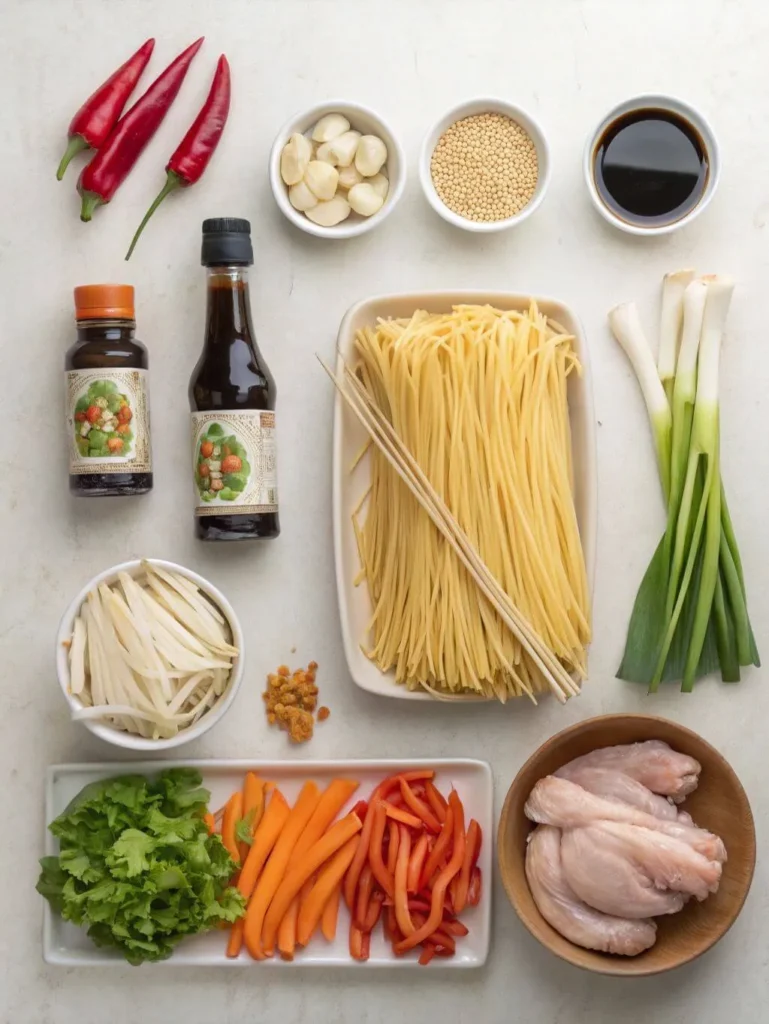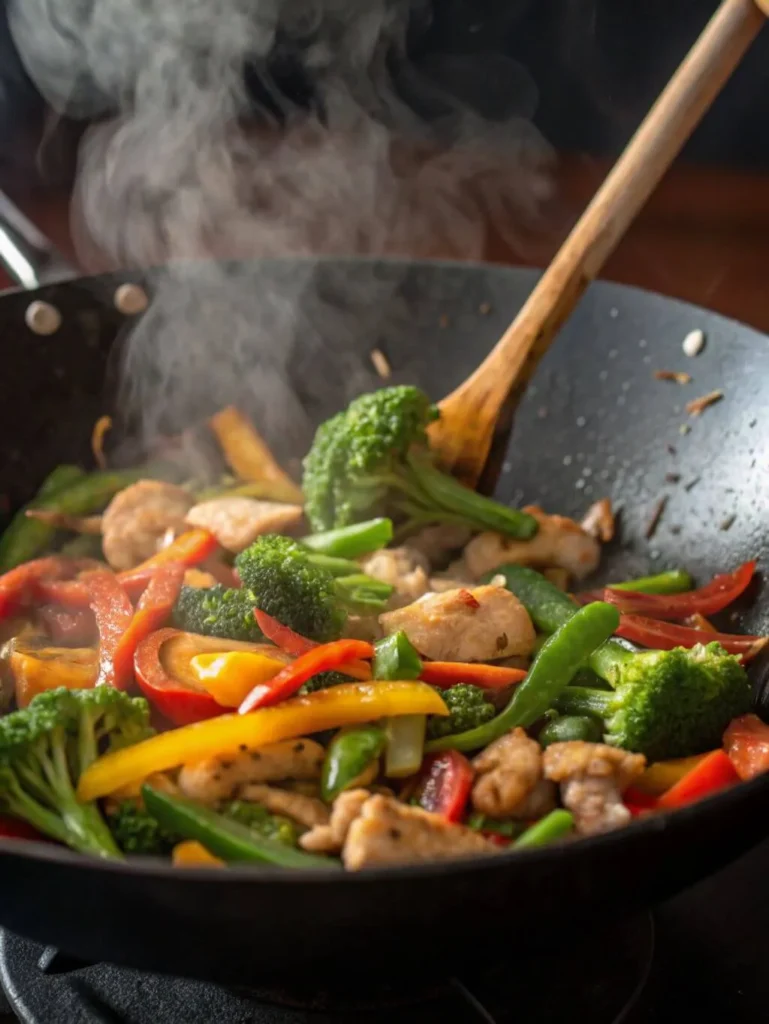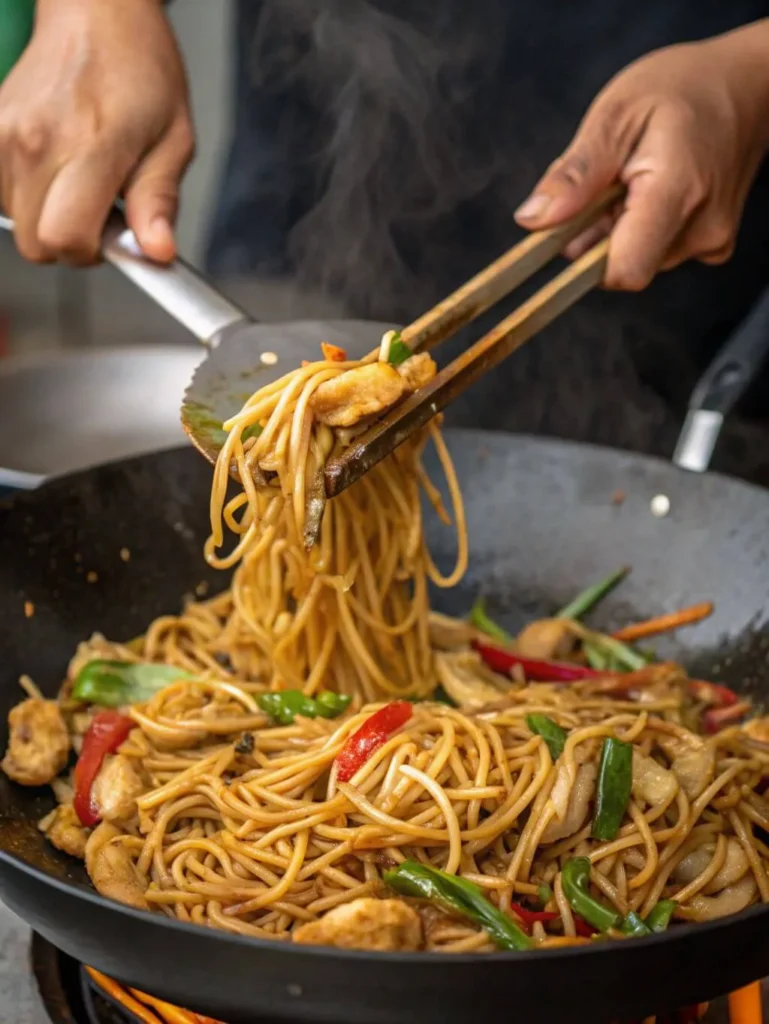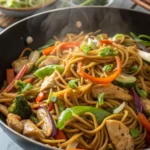Lo Mein. As Olivia, your noodle guide, I believe these noodles are more than just a dish; they’re comfort, connection, and a canvas for flavor. My culinary journey has proven that noodles bring people together, and this Lo Mein recipe is designed to do just that.
Forget bland takeout. This is the Lo Mein you’ve been searching for – vibrant, saucy, and deeply satisfying. Whether you’re a beginner or a seasoned cook, this recipe is simple and joyful.
Here’s why this homemade Lo Mein will become your new favorite:
- Authentic Flavor Profile: A perfectly balanced sauce, just like your favorite restaurant.
- Quick & Easy Weeknight Meal: Fast to prepare, ideal for busy evenings.
- Highly Customizable: Easily adapt with your preferred proteins and fresh vegetables.
- Better (and Healthier) Than Takeout: Control ingredients for a fresher, less oily, and more nutritious meal.
What goes in Lo Mein Noodles
Ingredients
To craft your perfect homemade Lo Mein Noodles, gather these fresh and flavorful ingredients:

For the Lo Mein Sauce:
- 1/4 cup low-sodium soy sauce
- 2 tablespoons oyster sauce (or vegetarian oyster sauce/hoisin for a vegan option)
- 1 tablespoon dark soy sauce (for color and deeper flavor, optional)
- 1 tablespoon rice vinegar
- 1 tablespoon granulated sugar
- 1 teaspoon sesame oil
- 1 teaspoon cornstarch
- 2 tablespoons water (for cornstarch slurry)
For the Lo Mein Noodles & Stir-Fry:
Salt and freshly ground black pepper, to taste
1 pound fresh or dried Chinese egg noodles (medium-thick)
2 tablespoons vegetable oil (or other high smoke point oil)
1 pound protein of choice (e.g., thinly sliced chicken breast, shrimp, beef, or firm tofu, cut into bite-sized pieces)
4 cloves garlic, minced
1 tablespoon fresh ginger, grated
4 cups mixed vegetables, thinly sliced or julienned (e.g., shredded cabbage, carrots, bell peppers, broccoli florets, snow peas, mushrooms)
2 green onions, sliced (white and green parts separated)
Equipment
To effortlessly create this delicious homemade Lo Mein Noodles, you’ll need a few essential kitchen tools:
- Large Pot: For boiling the noodles. Ensure it’s large enough to prevent the noodles from sticking together.
- Large Wok or Skillet: A wok is ideal for stir-frying, as its sloped sides allow for quick and even cooking. If you don’t have a wok, a large, heavy-bottomed skillet or Dutch oven will work well.
- Whisk: For easily combining the Lo Mein sauce ingredients until smooth.
- Cutting Board & Sharp Knife: For preparing your protein and vegetables efficiently.
- Tongs: Indispensable for tossing the noodles and ingredients together in the wok or skillet, ensuring everything is perfectly coated in the sauce.
- Measuring Cups and Spoons: For accurate ingredient measurements, especially for the sauce.
Step-by-Step Instructions
Get ready to create a truly irresistible Lo Mein dish! Follow these clear, detailed steps for perfect results every time. Remember, mise en place (having all your ingredients prepped and ready) is key for stir-frying success!

- Prepare the Lo Mein Sauce: In a medium bowl, whisk together the low-sodium soy sauce, oyster sauce, dark soy sauce (if using), rice vinegar, granulated sugar, and sesame oil. In a separate small bowl, whisk together the cornstarch and 2 tablespoons of water to create a slurry. Add the cornstarch slurry to the main sauce mixture and whisk until well combined and smooth. Set aside.
- Cook the Lo Mein Noodles: Bring a large pot of generously salted water to a rolling boil. Add the Chinese egg noodles and cook according to package directions until al dente (usually 3-5 minutes for fresh, or as directed for dried). Drain the noodles well and immediately toss them with about 1 teaspoon of vegetable oil to prevent them from sticking. Set aside.
- Cook Protein (if using): Heat 1 tablespoon of vegetable oil in your large wok or skillet over medium-high heat. Add your chosen protein (chicken, beef, shrimp, or tofu). If using chicken or beef, cook until browned and cooked through, about 3-5 minutes. If using shrimp, cook until pink and opaque, about 2-3 minutes. If using tofu, cook until golden and slightly crispy. Remove the cooked protein from the wok and set aside.
- Stir-Fry Aromatics & Vegetables: Add the remaining 1 tablespoon of vegetable oil to the hot wok. Add the minced garlic and grated ginger. Stir-fry for about 30 seconds until fragrant (do not burn). Add the harder vegetables first (e.g., carrots, broccoli). Stir-fry for 2-3 minutes, then add softer vegetables (e.g., cabbage, bell peppers, snow peas). Continue to stir-fry until the vegetables are tender-crisp, about 3-5 minutes more. Add the white parts of the green onions and stir-fry for another 30 seconds.
- Combine Everything: Return the cooked protein to the wok with the vegetables. Give the prepared Lo Mein sauce a quick whisk again (as cornstarch can settle) and pour it over the ingredients in the wok. Stir quickly to coat.
- Add Noodles & Toss: Add the cooked and oiled Lo Mein noodles to the wok. Using tongs, vigorously toss the noodles with the sauce, protein, and vegetables until everything is well combined and the noodles are evenly coated in the glossy sauce. This should take 1-2 minutes.
- Final Touches & Serve: Remove from heat. Stir in the green parts of the green onions. Taste and adjust seasoning with salt and pepper if needed. Serve your homemade Lo Mein immediately, hot and fresh!

Nutrition Information
(Approximate values per serving, based on 4 servings. These are estimates and can vary based on specific ingredients, portion sizes, and additions like protein or extra vegetables. They provide a helpful guide for health-conscious readers.)
- Calories: ~550
- Fat: ~25g
- Carbohydrates: ~60g
- Fiber: ~5g
- Protein: ~25g
- Sodium: ~1200mg (Note: This can vary significantly based on soy sauce and broth choices. Opt for low-sodium versions to reduce.)
- Sugar: ~8g (Primarily from sauce ingredients and natural sugars in vegetables)
- Saturated Fat: ~4g
- Cholesterol: ~70mg (Varies significantly with protein choice, e.g., higher with shrimp, lower with tofu)
Recipe Notes & Tips
To ensure your homemade Lo Mein Noodles are consistently perfect and customized, keep these expert tips in mind:
- Noodle Doneness is Key: For perfect Lo Mein noodles, aim for al dente. Slightly undercooking them (30-60 seconds less than package directions) is often best since they’ll cook briefly again in the wok.
- High Heat for Stir-Frying: A hot wok or skillet is crucial for flavor in your Lo Mein. Don’t overcrowd the pan; cook in batches if needed to maintain high heat.
- Mise en Place (Prep Ahead!): Chop and measure all ingredients before you start cooking. Stir-frying is fast!
- Customize Your Protein: Easily swap chicken, beef, shrimp, pork, or tofu. Ensure pieces are thin and bite-sized for even cooking.
- Veggie Power: Lo Mein is great for adding vegetables. Experiment with snap peas, bok choy, water chestnuts, baby corn, or bamboo shoots. Add harder veggies first.
- Adjust Sauce to Taste: Balance saltiness, sweetness, and tang for your Lo Mein sauce. A little extra sesame oil can boost aroma.
- Storage & Reheating: Store leftover Lo Mein in an airtight container for 3-4 days. Reheat gently in a skillet with a splash of water or broth to loosen.
- Make it Vegetarian/Vegan: Use vegetable broth and vegetarian oyster sauce. For vegan, ensure noodles are egg-free.

Lo Mein Noodles
- Total Time: 20 minutes
- Yield: 4 servings 1x
Description
- “Master authentic Lo Mein noodles at home! This guide by Chef Olivia reveals the best noodles, perfect sauce, and easy steps for a customizable, better-than-takeout meal!”
- “Lo Mein. As Olivia, your noodle guide, I believe these noodles are more than just a dish; they’re comfort, connection, and a canvas for flavor. My culinary journey has proven that noodles bring people together, and this Lo Mein recipe is designed to do just that. Forget bland takeout. This is the Lo Mein you’ve been searching for – vibrant, saucy, and deeply satisfying. Whether you’re a beginner or a seasoned cook, this recipe is simple and joyful.”
Ingredients
- For the Lo Mein Sauce:
- 1/4 cup low-sodium soy sauce
- 2 tablespoons oyster sauce (or vegetarian oyster sauce/hoisin for a vegan option)
- 1 tablespoon dark soy sauce (for color and deeper flavor, optional)
- 1 tablespoon rice vinegar
- 1 tablespoon granulated sugar
- 1 teaspoon sesame oil
- 1 teaspoon cornstarch
- 2 tablespoons water (for cornstarch slurry)
- For the Lo Mein Noodles & Stir-Fry:
- 1 pound fresh or dried Chinese egg noodles (medium-thick)
- 2 tablespoons vegetable oil (or other high smoke point oil)
- 1 pound protein of choice (e.g., thinly sliced chicken breast, shrimp, beef, or firm tofu, cut into bite-sized pieces)
- 4 cloves garlic, minced
- 1 tablespoon fresh ginger, grated
- 4 cups mixed vegetables, thinly sliced or julienned (e.g., shredded cabbage, carrots, bell peppers, broccoli florets, snow peas, mushrooms)
- 2 green onions, sliced (white and green parts separated)
- Salt and freshly ground black pepper, to taste
Instructions
- Prepare the Lo Mein Sauce: Whisk together soy sauce, oyster sauce, dark soy sauce (if using), rice vinegar, sugar, and sesame oil. Whisk cornstarch and water for a slurry; add to sauce and whisk. Set aside.
- Cook the Lo Mein Noodles: Boil salted water, add Chinese egg noodles, cook until al dente (3-5 minutes for fresh, or as directed for dried). Drain, toss with 1 tsp vegetable oil. Set aside.
- Cook Protein (if using): Heat 1 tbsp oil in wok/skillet over medium-high heat. Add protein; cook until done (3-5 min for chicken/beef, 2-3 min for shrimp, golden for tofu). Remove; set aside.
- Stir-Fry Aromatics & Vegetables: Add remaining 1 tbsp oil to hot wok. Add minced garlic and grated ginger; stir-fry 30 seconds. Add harder vegetables (carrots, broccoli); stir-fry 2-3 minutes. Add softer vegetables (cabbage, bell peppers, snow peas); stir-fry 3-5 minutes until tender-crisp. Add white parts of green onions; stir-fry 30 seconds.
- Combine Everything: Return cooked protein to wok with vegetables. Re-whisk Lo Mein sauce and pour over ingredients. Stir quickly to coat.
- Add Noodles & Toss: Add cooked and oiled Lo Mein noodles to the wok. Using tongs, vigorously toss noodles with sauce, protein, and vegetables until evenly coated (1-2 minutes).
- Final Touches & Serve: Remove from heat. Stir in green parts of green onions. Taste and adjust seasoning. Serve immediately.
Notes
- Noodle Doneness is Key: Aim for al dente Lo Mein noodles; slightly undercook for wok finish.
- High Heat for Stir-Frying: Crucial for flavor; don’t overcrowd the pan.
- Mise en Place (Prep Ahead!): Chop and measure all ingredients before cooking.
- Customize Your Protein: Easily swap chicken, beef, shrimp, pork, or tofu.
- Veggie Power: Lo Mein is great for adding vegetables; experiment with different types.
- Adjust Sauce to Taste: Balance saltiness, sweetness, and tang for your Lo Mein sauce.
- Storage & Reheating: Store leftovers 3-4 days; reheat gently with water/broth.
- Make it Vegetarian/Vegan: Use vegetable broth, vegetarian oyster sauce, and egg-free noodles.
- Prep Time: 5 minutes
- Cook Time: 15 minutes
- Category: Main Course
- Method: Stir-fry, Tossing
- Cuisine: Italian
Nutrition
- Serving Size: 4 servings
- Calories: ~550
- Sugar: ~8g
- Sodium: ~1200mg
- Fat: ~25g
- Saturated Fat: ~4g
- Carbohydrates: ~60g
- Fiber: ~5g
- Protein: ~25g
- Cholesterol: ~70mg
Keywords: angel hair pasta recipe, quick pasta, garlic herb pasta, easy dinner, weeknight meal, Parmesan pasta, vegetarian pasta
Serving Suggestions
Your freshly made Lo Mein Noodles are a complete meal on their own, but these versatile Lo Mein noodles also pair wonderfully with a few complementary dishes to create a full Asian-inspired feast! Serving your homemade Lo Mein with these delightful sides enhances the overall Lo Mein experience.

- Crisp Egg Rolls or Spring Rolls: A classic appetizer that provides a delightful crunch alongside your soft Lo Mein noodles.
- Steamed Dumplings or Potstickers: These are excellent with your Lo Mein, offering another delicious bite-sized savory element.
- Light Soup: A simple hot and sour soup or egg drop soup can be a refreshing contrast to your rich Lo Mein.
- Asian Cucumber Salad: A tangy, refreshing side that cleanses the palate after enjoying your flavorful Lo Mein.
- Additional Steamed Vegetables: If you want to boost your veggie intake even further, a simple side of steamed broccoli or bok choy is always a great choice with this Lo Mein recipe.
- A cold beer or iced tea perfectly complements your homemade Lo Mein.
- Enjoy every bite of your delicious Lo Mein!
FAQs: Understanding Lo Mein
To truly master homemade Lo Mein, it helps to understand the foundational elements that give this dish its distinctive character. As your noodle guide, I’ll break down the key components and answer some common questions, including those you’ve been asking!
What Type of Noodles Are in Lo Mein?
The heart of any Lo Mein dish is, of course, the noodles! For authentic Lo Mein, you’re typically looking for fresh or dried Chinese egg noodles. These are medium-thick, round, and have a wonderfully chewy texture that holds up beautifully to the tossing action of Lo Mein. They often contain wheat flour and egg, giving them a slightly yellow hue and a rich flavor.
Fresh Egg Noodles: These are often found in the refrigerated section of Asian grocery stores. They cook quickly and have the best chewy texture for Lo Mein.
Dried Egg Noodles: Available in most grocery stores, these work well too. Just ensure they are labeled as “egg noodles” or “chow mein/lo mein noodles.” Avoid very thin noodles like angel hair pasta, as they can break down too easily.
Dive into our comprehensive guide if you want to explore more noodle varieties?
What is the Difference Between Lo Mein and Chow Mein Noodles?
This is one of the most frequently asked questions in the noodle world, and for good reason! While both Lo Mein and Chow Mein use similar types of Chinese egg noodles, their cooking methods are distinctly different, leading to very different textures and overall dish experiences:
Lo Mein (捞面 – lāomiàn): Literally translates to “tossed noodles.” The noodles are boiled until al dente, then tossed with a flavorful sauce and other ingredients (protein, vegetables). The focus is on the soft, chewy texture of the noodles coated in a rich sauce. The noodles are the star, and they remain tender.
Chow Mein (炒面 – chǎomiàn): Translates to “stir-fried noodles.” For Chow Mein, the noodles are often pre-boiled and then stir-fried in a hot wok, sometimes until they become slightly crispy or browned. The emphasis here is on the stir-frying technique, which can result in a drier, sometimes crispy, noodle texture.
Think of Lo Mein as a saucy, tossed pasta dish, and Chow Mein as a stir-fried dish where the noodles get a bit more char and crispness.
The Perfect Lo Mein Sauce
The sauce is the soul of Lo Mein! It’s what coats every noodle strand, infusing the dish with its signature savory, slightly sweet, and umami-rich flavor. A classic Lo Mein sauce typically includes:
Soy Sauce: The foundation, providing saltiness and umami.
Oyster Sauce: Adds depth, sweetness, and a glossy finish (can be substituted with vegetarian oyster sauce or hoisin).
Dark Soy Sauce: For color and deeper flavor (optional).
Rice Vinegar: Adds a touch of tang to balance the richness.
Granulated Sugar: Balances the savory notes.
Sesame Oil: Aromatic and nutty, added at the end for fragrance.
Cornstarch Slurry: Thickens the sauce slightly, helping it cling to the noodles.
The key is to balance these ingredients to achieve a harmonious blend that’s neither too salty nor too sweet.
Protein & Vegetables: Your Customization Canvas
Lo Mein is incredibly versatile, making it perfect for using up whatever you have on hand or tailoring it to your preferences.
Popular Proteins: Sliced chicken breast, beef (flank steak or sirloin), shrimp, pork, or plant-based options like tofu or tempeh. Ensure proteins are thinly sliced for quick cooking.
Common Vegetables: Shredded cabbage, carrots (julienned), bell peppers (various colors), broccoli florets, snow peas, mushrooms, and snap peas. These add crunch, color, and nutrients.
Preparation Tip: Cut all your ingredients into similar, bite-sized pieces to ensure even cooking and easy tossing.
Explore More Noodle Recipes
Loved mastering homemade Lo Mein? As your noodle guide, I invite you to continue your culinary journey and explore more delicious noodle recipes from around the world right here on Easy Noodle Recipes!
- Italian Classics:
- For a rich and creamy indulgence, try our comforting Fettuccine Alfredo.
- Learn the art of making fresh pasta with our guide to Homemade Pappardelle.
- Whip up a timeless favorite with our Easy Spaghetti Recipe.
- Quick & Light:
- If you enjoyed the speed of Lo Mein, you’ll love our Angel Hair Pasta Recipe: Quick Garlic Herb Delight.
- Deep Dive into Noodles:
- Expand your noodle knowledge even further with our comprehensive guide on Noodle Types and Varieties.


5 thoughts on “Lo Mein Noodles: The Ultimate Guide & Recipe”